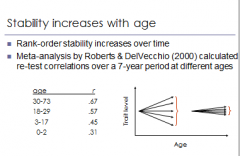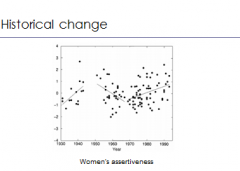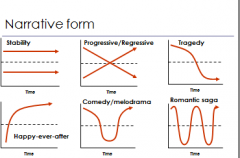![]()
![]()
![]()
Use LEFT and RIGHT arrow keys to navigate between flashcards;
Use UP and DOWN arrow keys to flip the card;
H to show hint;
A reads text to speech;
34 Cards in this Set
- Front
- Back
|
Who said “In most of us, by the age of 30, the character has set like plaster”? |
William James |
|
|
Who did the famous marshmellow test with 4 year olds? |
Walter Michel |
|
|
When Michel reexamined the same children 11-14 years later, he found the delay was associated with? (3) |
Greater planfulness Greater stress tolerance Better SAT scores |
|
|
Costa & McCrae report correlations of ~0.65 for the Big Five over a 20-year period after age 30. This longitudinal study is an example of what? |
rank order stability |
|
|
Does rank stability increase with age? |

Yes, especially after 30 yrs |
|
|
What causes personality stability? (6) |
1. Genetic influences 2. Environmental channelling (if people stay in the same place, then stability could reinforce personality) 3. Environmental selection (E seek out clubs, etc) 4. Freedom from disruptive life changes (migration) 5. Psychological resources (People with strong resources can bounce back after adversity – so might change less) 6. Identity formation |
|
|
A Cross-Sectional study is an example of what? |
Mean-level stability *but cohort effect might be at play |
|
|
Large web-based survey by Srivastava et al. (2003)Found evidence of substantial mean-level change in adulthood (ages 21-60). What did they find? (4) |
1. Agreeableness: increases, especially after 302. Conscientiousness: increases but plateaus after 30 3. Neuroticism: decreases in women only 4. Openness: decreasesExtraversion: increases (men) & decreases (women) |
|
|
What did the Mills College longitudinal study find about circumstances influencing personality change? |
Women who had children be age 27, correlated with becoming more responsible, tolerant and feminine, and less sociable and self-accepting than childless peers *DOES NOT PROVE motherhood causes this, but perhaps social roles, experiences, social influences change personality |
|
|
Do Young people typically become more agreeable & conscientious and less neurotic during the transition to adulthood? |
Yes (Soto et al., 2011) |
|
|
Are Educational challenges in transition from school to university are associated with growth in Conscientiousness? |
Yes (Bleidorn, 2012) |
|
|
Does Work attainment from age 18-26 associate with increased self-confidence & sociability, and decreased anxiety? |
Yes (Roberts et al., 2003 |
|
|
Does International sojourns for university students raise Agreeableness & Openness? |
Yes (Zimmerman & Neyer, 2013) |
|
|
Does Transition to first intimate partner relationship associate with lasting reductions in Neuroticism & shyness? |
yes (Neyer & Lehnart, 2007) |
|
|
Jean Twenge did Cross-temporal meta-analysis: comparing mean levels of attributes across time. What did she find? |
Rise in Self-Esteem Rise in Extraverion *Reflects the overall social environment that the personalities reside in |
|
|
What did she find with Women's Assertiveness? |

Reflection of the ups and downs of cultural revolutions. |
|
|
Who was the Entity/Incremental Theorist? |
Carol Dweck |
|
|
What are the challenges in putting numbers to slippery things like personality? (4) |
1. Assessment appears to be subjective 2. No infallible source of information about the person 3. The ‘object’ being measured knows it is being measured 4. Personality traits are not directly observable |
|
|
What is Reliability? |
does the measurement yield consistent, dependable & error-free information? |
|
|
What is Validity? |
does the measurement assess what it is intended to assess & is it useful? |
|
|
What are the three types of reliability? (by reducing error) |
1. Internal consistency 2. Inter-rater reliability 3. Re-test reliability |
|
|
What are the two components of Validity? |
Does the test measure what it is intended to measure? a. Content validity b. Convergent validity c. Discriminant validity Does the test provide practically useful information a. Predictive validity |
|
|
So for a good test of trait X …should ? (7) |
1. All items should intercorrelate [internal consistency] 2. The same score should occur whoever gives it [Inter-rater reliability] 3. People should get similar scores when they do it twice [Re-test reliability] 4. All items should clearly relate to the meaning of X [Content validity] 5. It should correlate strongly with other measures of X [Convergent validity] 6. It should not correlate with measures of Y & Z [Discriminant validity] 7. It should correlate with things that X is related to [Predictive validity] |
|
|
Which is more important? Reliability, validity or both? |
Reliability, because something can be reliable but not valid, but something cannot be valid without reliability |
|
|
What are (or have been) measures of personality? (even though they all have their draw backs) |
1. Interviews - Can try to provoke personality A (silences & interrupting) 2. Inventories - self report 3. Projective tests - Thematic Apperception Test (TAT) or Rorschach Test (blobs of black) 4. Implicit Tests - e.g. IAT |
|
|
Steffens & Schulze König (2006) did a study (haha of course they did!), on seeing if Inventory & implicit measures of same traits correlated. Did it? |
Inventory & implicit measures of same traits failed to correlate (mean r = .07) |
|
|
What are McAdams three levels of personality? |
1. Traits 2. Character adaptations 3. Life narratives |
|
|
Who pioneered psychobiolographies? |
Erikson |
|
|
What is a core component of Life Narratives? (think the story-like aspect) |
Identity (mcAdams) |
|
|
What are the 6 forms of Narrative themes mentioned in the lecture? |

|
|
|
What is Surgency? |
a trait aspect of emotional reactivity in which a person tends towards high levels of positive affect. It has been linked to the Big Five personality traits of extraversion in children.
|
|
|
What is the K scale? Think Yay-sayers, nay-sayers |
Do you like going to parties - Y Do you prefer to stay at home rather than go to parties - Y *evidence of K-scale tripping out |
|
|
What is the F scale? |
The infrequency scale - designed to detect random responses or very rare answers |
|
|
What is the L scale? |
Is the lie scale - faking good, faking bad |

